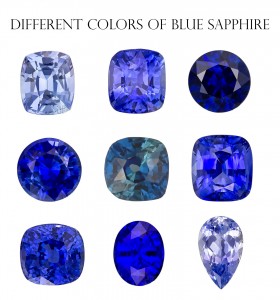Sapphires have once again become an increasingly popular center stone choice for engagement rings and even right hand rings. At Lauren B we love the look of these colorful stones which add a lot of character to an otherwise ordinary ring. To give you some context, sapphires are a precious gem stone along with rubies, emeralds, and diamonds. Sapphire which mineral make up is Corundum is a very hard, durable, and stable stone making it suitable for everyday wear; they have a hardness of nine on the Mohs scale whereas diamonds are a rated as 10. SSapphires have been used as an engagement ring center stone since the Victorian Era. In modern day, sapphires give off vibes of old-world romance. Think that Kate Middleton’s gorgeous 18 carat sapphire engagement ring was originally presented to Princess Diana! If you love color and are looking for an alternative engagement ring or right hand ring, consider a blue, pink, or hybrid sapphire for your center stone. A red sapphire is considered a ruby!
In terms of sapphire quality, there is a very large variety. The jewelry industry has yet to standardize a consistent grading scale for sapphires whereas diamonds for example have very strict guidelines. Because of this we do our best to guide each client through the process of selecting a sapphire that best suits their visual needs and budget considering there is no true ideal a sapphire. It will vary from stone to stone considering what is most important to you. Below are some different factors to consider for your sapphire ring and you can also check out some videos of loose sapphire gemstones here on our website.
Treatment: Treated sapphires are very common and they make up the norm in today’s market. Untreated sapphires are more rare and therefore much more expensive. Sapphires are very commonly heat-treated to improve color, clarity, and overall appearance. Some sapphires are found closer to thermal venting in the earth, which produces exceptional color through natural heating.
Carat weight: Sapphires tend to be heavier than diamonds and therefore a 1 carat diamond is going to look bigger than 1 carat sapphire. It is best to go by not only carat weight but millimeter measurements to give you the most best idea of how it will appear once set in a ring.
 Color Sapphires comes in a rainbow of colors from pink, orange, yellow, red, green- you name it! Blue sapphire is the most popular of the bunch. Color has the most important influence on the price of a blue sapphire. The most prestigious and rare blue sapphires are according to GIA velvety blue to violet blue, in medium to medium dark tones. A sapphire that is extremely light, extremely dark, or grayish is going to be less expensive. Hue refers to the actual body color of the sapphire. It is usually comprised of two parts, the color that has the strongest presence, and any other colors that may be slightly noticeable, giving a certain undertone to the stone. The main body color/most obvious color is listed second and the undertone color is listed first. For example you can have a greenish blue sapphire or a blueish purple sapphire. The main body color is listed second and the undertone color is listed first. Again, because of lack of standardization it is up to the viewer to really look at the stone and see which one captivates you and draws you in the most.
Color Sapphires comes in a rainbow of colors from pink, orange, yellow, red, green- you name it! Blue sapphire is the most popular of the bunch. Color has the most important influence on the price of a blue sapphire. The most prestigious and rare blue sapphires are according to GIA velvety blue to violet blue, in medium to medium dark tones. A sapphire that is extremely light, extremely dark, or grayish is going to be less expensive. Hue refers to the actual body color of the sapphire. It is usually comprised of two parts, the color that has the strongest presence, and any other colors that may be slightly noticeable, giving a certain undertone to the stone. The main body color/most obvious color is listed second and the undertone color is listed first. For example you can have a greenish blue sapphire or a blueish purple sapphire. The main body color is listed second and the undertone color is listed first. Again, because of lack of standardization it is up to the viewer to really look at the stone and see which one captivates you and draws you in the most.
Clarity Clarity is different for sapphires than for diamonds. A completely flawless sapphire would be extremely hard to find. Whereas diamonds clarity are graded based on their clarity at 10x maginification, sapphires will be looked at based on their visual appearance. The main idea is a very clear sapphire will look eye clean. Commonly standard sapphires will have tiny imperfections however the color of the gem detracts from the imperfections becoming very obvious.
Cut Like diamonds, sapphires are cut in the same shape styles. Options would be round, cushion, oval, emerald etc… In terms of grading the cut of the sapphire, there is a lack of standardization considering each stone is cut to maximize it’s color influence because color is the most important. Sapphire cuts are generally not graded by gem laboratories because these command a very high premium. In general, a well-cut sapphire will be symmetrical and reflect light at the proper angles in order to enhance the stone’s luster. Instead, focusing on the color and visual appearance of the sapphire will yield the most beautiful end result for your custom jewel.
Stay tuned for our next post where will break down some options on designs and how to incorporate sapphires into your next custom ring!
